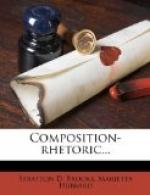He rode, not a mule, like his companion, but a strong hackney for the road, to save his gallant war horse, which a squire led behind, fully accoutered for battle, with a chamfron or plaited headpiece upon his head, having a short spike projecting from the front. On one side of the saddle hung a short battle-ax, richly inlaid with Damascene carving; on the other the rider’s plumed headpiece and hood of mail, with a long two-handed sword, used by the chivalry of the period. A second squire held aloft his master’s lance, from the extremity of which fluttered a small banderole, or streamer, bearing a cross of the same form with that embroidered upon his cloak. He also carried his small triangular shield, broad enough at the top to protect the breast, and from thence diminishing to a point. It was covered with a scarlet cloth, which prevented the device from being seen.
—Scott: Ivanhoe.
Notice also how the description proceeds in an orderly way from one thing to another, placing together in the description those which occur together in the person described. Just as we turn our eyes naturally from one thing to another near it in space, so in a paragraph should our attention be called from one thing to that which naturally accompanies it. If the first sentence describes a man’s eyes, the second his feet, and a third his forehead, our mental image is likely to become confused. If a description covers several paragraphs, each may be given a unity by placing in it those things which are associated in space.
EXERCISES
A. If you were to write three paragraphs describing a man, which of the following details should be included in each paragraph?
(a) eyes, (b) shoes, (c) size, (d) complexion, (e) general appearance, (f) hair, (g) carriage, (h) trousers,(i) mouth, (j) coat, (k) nose.
B. Make a list of the details which might be mentioned in describing the outside of a church. Arrange them in appropriate groups.
C. In the following paragraphs which sentences give the general outline and which give details? Are the details arranged with reference to their position in space? Can the paragraph be improved by rearranging them?
1. We came finally to a brook more wild and mysterious than the others. There were a half dozen stepping-stones between the path we were on and the place where it began again on the opposite side. After a few missteps and much laughter we were landed at last, but several of the party had wet feet to remember the experience by. We found ourselves in a space that had once been a clearing. A tumbledown chimney overgrown with brambles and vines told of an abandoned hearthstone. The blackened remnants of many a picnic camp fire strewed the ground. A slight turn brought us to the spot where the Indian Spring




